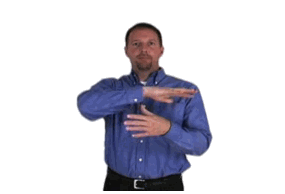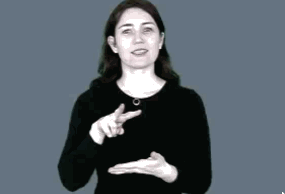October 27, 2015 - 23:19

Overarching idea: Deaf culture, Deaf capital, the use of ASL, and universal design all provide us with new ways of accessing all classrooms, communication, and performance, but specifically within our classroom at the prison.

[the above should be, should it work, a gif of an individual signing "inclusion". when i learned the sign for inclusion, i got the idea to make gifs to intersperse with the text. it is possible that the gif will only play once through, so it might be helpful to 1. right click, 2. open image in a new tab. from there, you should be able to reload that page as many times as necessary to see the sign. i'm still learning how to edit gifs using various software, so i apologize if that's the case.]
Now, the beginning sections of this may seem to deviate a bit from focusing directly on the classroom (and, admittedly, it does a bit). This is because I want to examine very definition of performance and performativity. I want to do this because, in our talks with Sheila, it was suggested that Sula, Joie and I perhaps focus on the idea of performance in our final project involving our prison-based research. I began to wonder what performance even means, and how performance differs from our conversations, art galleries, literatures, etc. in the context of a final projects and in our classrooms at the prison. Jody and I then began to talk a little bit about how body, voice, and performance maybe separate, but in some instances like with the use of signed languages are one and the same.
The legitimacy of sign languages is often erased, given the emphasis on (and, frequently the actual defining of) language as solely spoken and written. (this delegitimizing of sign languages combines - at least in Western and colonize[d/r] areas – ableism, linguisticism, and phonocentrism.) For example, the phrase “to talk with your hands” usually means, to verbal individuals, spoken language but with the addition of hand motions. Their (our, as verbal individuals) hands in-motion are perceived as performative – but oftentimes, this is only the hand motions and not the verbal nature of their (our) speech. Some folks find hand motions of this type illegitimate to a conversation, while in other situations, such as in the realm of public speaking, some hand motions are encouraged -- but only to keep the audience engaged, and only as long as the hand motions are kept within a certain, small range. Again, such hand motions are considered additives, not fully necessary to the act communication.
Performativity itself, I believe, is in many situations perceived as inherently unnecessary. In my experience, the term “performance”, especially when in the context of emotional reactivity and conversation, has a specific connotation of being stagy, artificial, and inauthentic.

[the above is a gif of an individual signing "performance" in ASL. i also made this image so it better work or i'll cry.]
However, I’ve found that many people will admit to staging conversation in some manner so that they can create verbal language to be understood in certain ways – so, yes, even if performativity here means “stagy”, there is often a performance aspect in everyday verbal communication. One might recite how they will talk in the phone before placing a call. When we write emails or essays, we tend to edit so that we can be understood. An extension of performance goes into the ways in which we verbal individuals even speak the words; many people will put varying amounts of “weight” on certain words or parts of words, using different pitches and loudnesses when speaking. And when individuals do not put these performances into place, that person may not be fully understood. If a person also doesn’t continue this performance, they might be considered to have blunt or flat affect – which is a way of pathologizing the differing modes of communication.
The negative stigma of performance in emotional reactivity results, in part, in delegitimizing sign language (and also the communication of those with flat affect, which I simply don’t have the space or knowledge to write about in full…). ASL relies on the use of hands and facial components to convey meaning and emphasis beyond how words alone might be perceived. For example, Diane Brentari uses the phrase “visual sonority” in reference to emphasis and “weight” on a grammatical unit (i.e., a syllable, word, phrase, sentence, etc.) that is created from the use of the hands and face. This is almost the same ways that verbal language varies in pitches and loudnesses. Yet if someone were to move their hands and arms in large motions to convey a meaning, they might be considered as an extreme opposite to flat affect.
How does performance go into the classroom? The association of classroom and performance often relates to how “well” you are doing in that space. You are required to “perform” for the teachers/professors and often to your classmates. So, then, aren’t all our communications performances? We perform for each other in communicating so that we may be understood, and also we perform simply by doing. In accepting performance as valuable to a classroom space, we can allow a text to ‘“speak” for itself’ rather than trying to concentrate and drain the performance into an oversimplification.

[the above is a gif of an individual signing "perform", or "to do", in ASL. another gif of mine, sorry for the random cameo of my computer cursor]
Once we try to get at this internalized ableism and audism, I think accepting all forms and modes of communication is necessary to create a full educational experience. Now, I can’t think of a way to incorporate every language into a single classroom. But I think a classroom needs to be as accessible as possible. And I think that audism and other ableisms against those with mutism and communication disorders plays a very powerful part in access to education. There are schools for Deaf and visually impaired people, but that doesn’t incorporate universal design or acknowledge how there are just a huge number of ways that communication occurs. Autistic individuals, people with anxiety disorders… even, if such exists, a fully abled person can benefit from re-examining communication and in which we understand one other.
“Because we got it wrong, we must now take a second look at…
- literacy…
- the notion of literature…
- the notions of how humans learn…”
-- Dirksen Bauman (video below)

[another gif i made. it is hypothetically of an individual signing "literate", should it work.]
How do re-examine these things in a classroom? I think a classroom based on universal design – in which we make room for not only the students who are hearing and verbal, not only Deaf students, not only students with mutism, but for everyone who wishes to communicate in the most understandable ways possible – is the answer.
For one, I think this sort of education and altered style of communication could really benefit if we start “from the ground up” – meaning with pre/non-verbal infants and those in early elementary education having sign used and taught (Vallotton). However, I won’t examine that here, as I wish to really get at how ASL, re-examining communication, and universal design can affect our education and performance in our prison classroom (and perhaps in our 360 classes).
Dirksen Bauman’s TEDxGallaudet talk, toward which Anne and Jess Libow directed us, cites a classroom where we all can establish eye contact with one another as an imperative. I believe that eye contact is not required, however, for all forms of communication; for example, visually impaired individuals may not be able to do this at all. That being said, I think this idea of creating an equality in positioning, and one in which everyone can be seen and/or heard, is still very valuable. The round(ish) ways of creating our space is the first in making the environment a proper performance space.
if the video doesn't work: https://www.youtube.com/watch?v=yCuNYGk3oj8
Peter Hauser also gave a TEDxGallaudet talk, in which he describes Deaf capital as “knowledge and skills from the Deaf community… [that] is almost like a toolbox… When you meet other Deaf people, you gain knowledge from their experience of navigating the world.” (I do believe this idea came before the TEDx talk, but I would like to keep using TEDx here, since it allows folks to access through video and multiple languages). In valuing personal experience as equally as possible, we can recognizing the different tools and proficiencies we individually have.
if the video doesn't work: https://www.youtube.com/watch?v=73zUW76OOxg
“To motivate [students], we need literature that speaks to them… to influence their autonomy.” Santini brings in a key point about motivation and learning based on more of a give-and-take model in which students can actually affect the path of their education in his talk on autonomy in Deaf education. “…[S]tudents [often] do not have the freedom to make personal choices about their school environment. Academic staff and faculty are often unaware of the effect they have on student autonomy.” He cites autonomy in examples of how students should be able to affect what texts are available and what info is covered. “[There is] an importance of listening from the students to get their own experiences to aid in their education.” [CITE] Santini’s talk was on how to make the classroom a more accessible space for Deaf students, but, in many ways, this is simply how one might make a classroom more universally accessible. Allowing the incarcerated individuals more space to give feedback on subject matter, on interests, on identities they hold, etc. will allow us to create a more holistic classroom and educational experience. Their feedback, their performance, and their conversations should affect what material we put forth in our lessons. It is, in a way, a feedback loop where our experiences inform the structure and performance, and then their performance informs how we should change the classroom.
if the video doesn't work: https://www.youtube.com/watch?v=YiptJm48Ghk
Since researchers have found an increase in literacy and communication skills in children who utilize sign in early childhood (Vallotton), and because there have been many studies done on the linguistic benifits of knowing two or more languages, I think we can assume, by extension, that incorporating varied forms of communication can help us understand ideas and concepts - whether it be through differing forms of language(s) or through performances. I also hope that we can do our best to understand, interpret, re-examine, and re-form each other and our educational spaces.
This short essay is in no way a summary disability (or specifically Deaf) theory, but more of a "jumping off" point to look more into disability theories to understand the ideas of performance, communication, and educational spaces.
Brentari, Diane. A Prosodic Model of Sign Language Phonology. Cambridge, Massachusettes: MIT Press, 1998. Print. Language, Speech, and Communication.
TEDx Talks. A Dangerous Idea: Autonomy in Deaf Education | Joseph Santini | TEDxGallaudet. Film. https://www.youtube.com/watch?v=YiptJm48Ghk.
---. Effects of Linguisticism and Audism on the Developing Deaf Person | Peter Hauser | TEDxGallaudet. Film. https://www.youtube.com/watch?v=73zUW76OOxg.
---. On Becoming Hearing: Lessons in Limitations, Loss, and Respect | Dirksen Bauman | TEDxGallaudet. Film. https://www.youtube.com/watch?v=yCuNYGk3oj8.
Vallotton, Claire. “Signing Time Research.” Signing Time. 22 Jan. 2015. Web. 15 Oct. 2015. http://www.signingtime.com/resources/research/.

Comments
signing as a way to reconceptualize 'performance'
Submitted by jccohen on November 7, 2015 - 14:16 Permalink
Rb.richx,
First, a tech note: I like the idea of the gifs! And/but I had trouble using them, and am not sure whether this is about what I’m doing or how they’re working (or both). For example, the third gif (perfect that this is signing ‘perform’) seems to work as long as I’m located there in the text, but not the one before and after…
Your use of sign language as a kind of exemplar of the intersection between ‘voice,’ ‘body,’ and ‘performance’ is a compelling way to revise our understanding of what each of these is/could be. In this way the gifs are a beautiful piece of this essay, an insistence that words alone or even word and image gives us a static and in this sense incomplete experience of identity and communication. In terms of this question of what’s integral (‘rather than additive’) to voice, I think Anna Deveare Smith can bring some illumination, especially with regard to her idea that character lives most deeply not in the words but in the pauses/gaps/gestures between words. This is obviously different from signing, but interestingly, it similarly attends to the ways that our reliance on the verbal may get in the way, and a clue to how thinking in terms of “disability” helps us think also for all of us – as you get to later.
“If a person also doesn’t continue this performance, they might be considered to have blunt or flat affect – which is a way of pathologizing the differing modes of communication.” I’m really struck by this line as an indicator of how narrowly we define what’s “appropriate” in terms of voice, bodies, communication. You go on to elaborate this idea in the contexts of the classroom and also daily life, revealing performance as a more self-aware, deliberate way of being in communicative relationship. I’m thinking about this again in relation to Anna Deveare Smith’s performance, which can certainly be uncomfortable to watch (and I’m remembering your participating in that discussion); might it be, though, that she’s making visible what we all do in performing as relating/communicating? In this regard I’m especially curious about the ‘illiteracy’ gif, which I haven’t been able to see/read…
I very much appreciate your point about creating a more accessible classroom as a key to our classes in the jail, and specifically to “allowing the incarcerated individuals more space to give feedback on subject matter, on interests, on identities they hold.” This strikes me as both a powerful and important indicator for our work inside, and also a reminder of what I see as inevitable limitations to access. What about constraints on what we can open up in that space, and likewise, what about constraints on creating spaces that are fully/completely accessible to all?